
Award plaque designed by Potter Gopalan
We were highly commended at the First Choice Responsible Tourism Awards 2006 in London, Condé Nast Traveler World Savers Award 2007 and came runner up in 2008 Travel Mole Asia Responsible Tourism Website category. The recognition is continuing and we are glad to share many other awards in 2009 as an acknowledgement of the quality of holidays we are offering to discerning travellers to India.
*The Week ( 15 Healthy things to do in 2009)
*Footprint Handbook 2009 amongst the "6 very best sustainable Tourism initiatives in India"
*Irish Times recommends us in the "5 eco trips for 2009"
*Rough Guides "Clean Breaks: 500 New Ways to See the World" by Richard Hammond and Jeremy Smith, published August 2nd 2009
Kevin Rushby visiting River Nila (pic Arun Prabhakaran)
Even though all these awards are encouraging and we are proud to receive such recognition, there will be no award that will match what we received in December 2007. This was given to us by the communities that we work with, who gave a memento to The Blue Yonder for bringing in attention to the region and for the efforts we have taken to revive and support art forms along Nila. Amongst all other recognition we have received in the last four years, we don't think there will be any other that will remain so close to our heart than this appreciation from our own people.

Potter Gopalan at his workplace (pic Susanna Hagen)
Story of Gopalan, the potter: When we met Gopalan 4 years ago, he was a another struggling potter in Arangottukkara with occasional work orders. He is from a community called 'Kumbhara" a group of traditional potters that migrated from Andhra Pradesh many hundred years ago searching for an ideal location to work on the only skill they had. Like many other communities that settled on the banks of the Nila from different parts of the country, the Kumbhara community also made it their permanent base. The clay on the banks of the river was so refined that they could create magic out of it. For the skills and the culture they brought in, they stood out amongst other people. When we were growing up as kids, we found them funny because of the dialect they used to communicate amongst themselves! They were not talking Malayalam, instead they were talking a dialect that originated from Telugu and Malayalam.
At some point of our growing up, we saw the magicians in them. We got closer to them. We saw how they tame the clay on a cart wheel and how the raw clay turned into such beautiful artifacts at the whims and fancies of their skilled fingers!. There were plates, vases, mugs and all that our parents used in our kitchens. To know that the food that was cooked lovingly for us came from the magic created by Kumbharan community, it brought us even more closer to them.
We all moved on. From our village, away from our river, we went travelling. Some for studies, some for jobs, some to escape the village lives. Some of us ran away from our nosey relatives! But when we came back to the smell and breathe of our river later, one of the first nostalgic memories that came back to us were of these potters! The art they used to weave, the cultural richness that made the river valley civilisation so unique.
'A burnt down river-bed!' in Palakkad district (pic Sandra Wels)
The same river that was once a lifeline of Malabar region in Kerala is now struggling because of human greed and intervention. We dammed it, we cut all trees possible in the catchment areas, we stopped farming by the side of the river, squeezed out every single drop of water available and finally started taking away even the fine sands on the banks of the river to build our houses.
The river gave all it can, we demanded more. The river laid it all bare, we opened up her chest. In the place of fine sand and shallow water that formed the river bed, all we see is wild grass that stands taller than us. There was a time when we couldn't see what was on the other side of the river because of the water that was touching on both the banks. Now we can't see what is on the other side of the river because of the tall grass that is growing so wild.
The river that made many of us romantic and passionate human beings, was disregarded. We stopped listening to her cries, we went on with our lives as if she was no longer part of it. There was a time when we used to see workers from mountains coming into our villages on bamboo barges that were cut in the high mountains of the western ghats. We use to playfully climb on them and go with from Thrithala to Kuttipuram and then to Tirunavaya and Chamravattom. The brave ones climbed on to the slippery barge, the rest swam along for some distances. But all those memories are bygone. Our kids don't believe any more when we tell them that there was a beautiful river there. Once! Not too long into the past, but just a decade ago!
In modern times however, people like Gopalan is struggling to sustain his only known skills (even with more and more work orders coming in), because the younger generation don't even want to take up this as a profession. No one wants to 'dirty' their hands any more. But this doesn't stop the man from exploring new dimensions into his work. When the community that we work with along the Nila decided to appreciate the impact of Responsible Tourism in their day to day lives, they approached Narayanan to create the memento that depicts the universal eco-living!
Work orders from travellers (Pic: Birgit Bermann)
We are however glad to share Narayanan's words to a documentary film maker who recently visited Nila. "Social recognition to my work was the most important contribution of Responsible Tourism to our community and also this brought in more work orders from curious travellers, and locals and even from small resorts and restaurants who were trying to incorporate traditional values in their business. Actually in the last few months, we have been looking for assistants to help us complete our work as the work orders have increased!! "
© The Blue Yonder 2009
Labels: Awards, Pottery, Responsible Tourism, River Nila
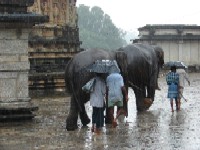
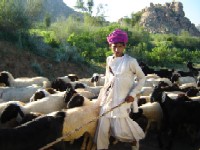
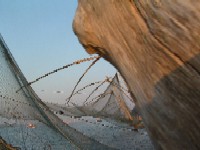

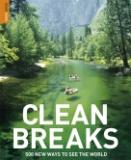
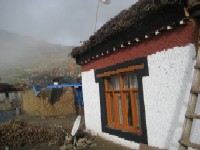
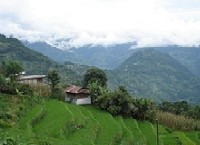
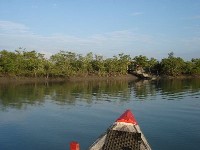























hi. Firstly, congratulations on the award.. it's beautiful .
A part of Gopalan's life sounds makebelief, a pristine place we imagined would always be there for us to escape to. However, i think humans often tend to take things that matter the most for granted, think they expect to be taken care of, but this ignorance has caused us to lose things that have been truely sacred. Gopalan deserves the fertility and abundance of these elements, but out of no fault of his own he's slowly watching all that he revered and that has nurtured him falling prey to all this confusion. I'm glad this reality is being recognized and spread by concerned people like you and efforts are also being made to balm the injuries caused.
I want to learn pottery, and was wondering if Goppalan would be keen on teaching me and others interested. Also maybe schools could organize fieldtrips to make chidren more aware of these traditional arts and practices. And if Goppalan's future generations are educated about how rare and important this art and the soil which supports it is and how much it's appreciated by people world over, they might make more efforts to conserve what is still left... is that possible?